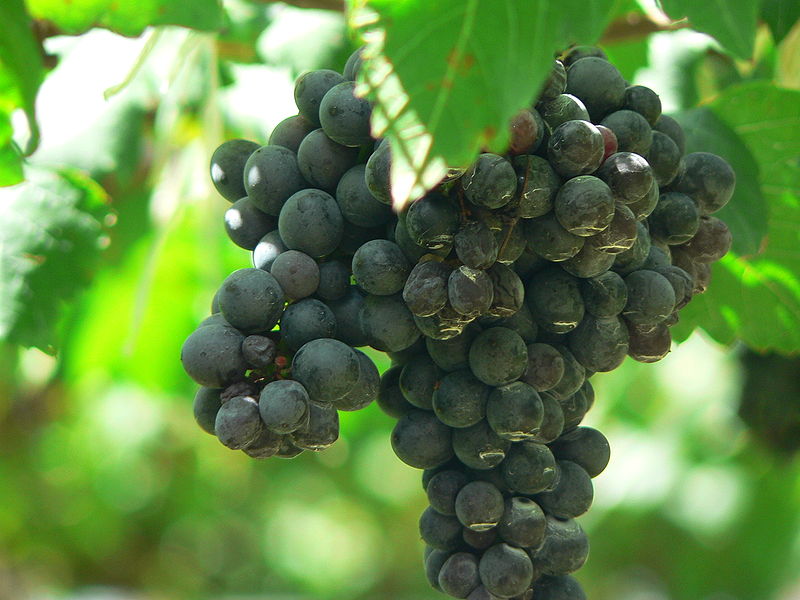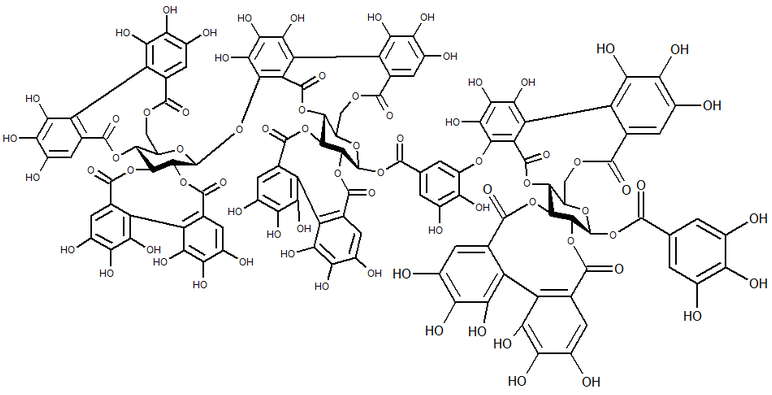In the last post on plant secondary metabolite, I discussed extensively on Flavonoids. Flavonoids are groups of polyphenols that impart colour in plants, through the colour, they provide an attraction for the plant thereby inviting pollinators to visit such a seed-bearing plant(Spermatophyta). They are also useful to human in preventing diseases that are life-threatening. In that last post that could be found here, I explained that Flavonoids are very important to human health because of their antioxidant properties as well as their cell survival signalling pathway properties. You can just check the link shown. In this series, I will base the discussion on Tannins

What are Tannins?
A glass of wine in your hand at any particular point in time actually contains some levels of polyphenols especially if it is a bottle of red wine. The astringent taste your mouth feel after taking a glass cup of that red wine is as a result of its polyphenolic compound content called tannin which is richly found in grape an important ingredient in winemaking.
Own work, CC BY-SA 3.0 commons.wikimedia Tempranillowine  )
)
In fact, maybe we should say no tannin no red wine because it affects the colour, texture, and longevity of the wine. They impart that bitterness and drying sensation you feel in your mouth as a result of their reaction with saliva protein. The term tannin for the plant metabolites was actually being used in the tanning of animal skin in which the protein structure of the animal skin is completely altered to make it durable and prevent spoilage.
So what are tannins and their sources?
Tannins are groups of secondary plant metabolite that have properties of precipitating protein in an aqueous medium. They form complex with protein and that is why most times its been removed while processing food for protein to be available. Their molecular weight ranges between 500 and 3000 Da (Dalton). They are mostly found naturally in a complex form with sugars, protein, and alkaloids and when such is the case, their weight could be as high as 20,000 Da. Their chemical structure is a function of the plant species that produce them. The literature currently has a record of around 8000 different tannins so far isolated from different plants while work is still progressing to isolate more from plants. When you take a sip of wine, the astringent feel you have in your mouth is a result of the tannin binding with the salivary proteins such as α‐amylase, peroxidase, lysozyme and many other salivary proteins. The complexes formed when tannins combine with protein remain insoluble in water and so the protein remains indigestible. Tannins are largely found in different proportions in Pomegranates, blueberries, strawberries, cranberries, nuts, herbs and legumes. They can be found in different part of plants such as the stem, bark and root. Tannins are different based on their structures. While some plant sources are highly rich in tannin, some have a relatively low amount of this polyphenol depending on the plant part where these compound are situated.

Classification of Tannins
Tannins are majorly classified into two groups; Hydrolysable tannins and Condensed tannins. The hydrolysable tannins are further classified into ;
- Gallotannies;
- Ellagitannines; and
- Complex tannins.
The hydrolysable tannins are simple in their structures. They are mixtures of simple phenols and sugars that are esterified in the presence of enzymatic, acidic or alkaline hydrolysis. They can be hydrolysed by heating the to Gallic or Ellagic acid by simply heating with Hydrochloric acid or Sulphuric acid.

The Condensed tannins (Which can not be hydrolysed ) mainly proanthocyanidins contain carbon chain resembling flavonoids. Although both classes are different in structures, they both exhibit antimicrobial property, however, Condensed tannins tend to resist degradation by microbial activities and that is why they are more useful in antimicrobial activities. Condensed and hydrolysable tannins are derivates of flavan-3,4-diol and gallic acid respectively. The condensed tannins are complex in their structure and are difficult to hydrolysed, however, they are soluble in an aqueous organic solvent. They are rich in the OH group which is bonded to protein using hydrogen bond. They are the most abundant of all the tannins known on a commercial scale. In the production of wine, they are the one responsible for the astringency taste.
Medicinal properties of Tannins
Tannins are already labelled to be ( antinutrients) that is, they are responsible for low feed intake, low growth rate, low net metabolizable energy and protein digestibility in animals used for experiment. So it is commonly said that tannin-rich food is considered to be of lower nutrient value. However, a lot of findings has shown that tannins are not really responsible for inhibiting food digestibility, but tannins are only poor in releasing nutrients that the body can utilize. Most times people are advised not to take any diet rich in tannins because of the fear that their food may end up not being digested. Also, reports indicated that tannins bind with Iron in the food, so those who have Iron deficiency are always advised not to take tannin-rich food to prevent an Iron shortage. Also, some have reported that food rich in tannins are of the capacity to cause oesophagal cancer. It is believed that the uncontrolled intake of the food rich in tannins can make consumers prone to cancer.
Despite what seems to be a bad side of this group of Phytochemicals, It has great medicinal value as these groups of the plants chemical are even secreted for plant protection against diseases causing organisms. The flavonoids resembling tannin also referred to as Condensed Tannin is one of the most recognisable natural plant product that is known for its pharmacological activities after been isolated from the plant that housed it. The Pharmacological activities of tannins are connected to its hydroxyl group located on the tannin. This hydroxyl group is attached to adhesins ( a protein with which bacterial binds itself to a host cell surface) by forming a hydrogen bond with the -NH- group of the bacterial protein. This attachment is hardly cleaved even by the bacterial digestive enzyme. So the result of the hydrogen bond formed between the OH- group from tannins and the NH- group of the bacterial protein leads to the inhibition and subsequent rupturing of the cellular membrane of the bacteria. Aside from their antibacterial activities, their anticarcinogenic and antimutagenic properties have also been reported due to their antioxidative abilities by giving up their own electrons thereby breaking a long chain radical activities which could lead to oxidative stress. Tannins also prevent oxidation that could have led to Fenton reactions in the cell by chelating metal ions such as Fe(II). Fenton reaction is a reaction that converts hydrogen peroxide obtained after oxidative respiration into very toxic free radical.
Conclusion
We could say to some extent that Tannins are really important in the wine industry as well as the leather industry. It uses, however, does not stop at those as they are also being used to medicinal purposes which modern-day research has also established. However, its consumption too should be controlled because of its antinutrient factor.
References
(1) https://en.wikipedia.org/wiki/Tannin
(2) https://www.winemag.com/2018/09/11/tannins-wine-guide/
(3) https://www.ncbi.nlm.nih.gov/pmc/articles/PMC6259628/#
(4) https://en.wikipedia.org/wiki/Phenolic_content_in_wine#Tannins
(5) https://en.wikipedia.org/wiki/Hydrolysable_tannin#
(6) (PDF) Tannins obtained from medicinal plants extracts against pathogens: antimicrobial potential”. Available from: https://www.researchgate.net/publication/287998574_Tannins_obtained_from_medicinal_plants_extracts_against_pathogens_antimicrobial_potential [accessed Oct 15 2020].
(7) https://onlinelibrary.wiley.com/doi/pdf/10.1002/ejlt.200700145#.
An excellent post. We have submitted it for the Community Incubation Project (OCD) vote. Good luck!
Congratulations @steepup! You have completed the following achievement on the Hive blockchain and have been rewarded with new badge(s) :
You can view your badges on your board and compare yourself to others in the Ranking
If you no longer want to receive notifications, reply to this comment with the word
STOPDo not miss the last post from @hivebuzz: